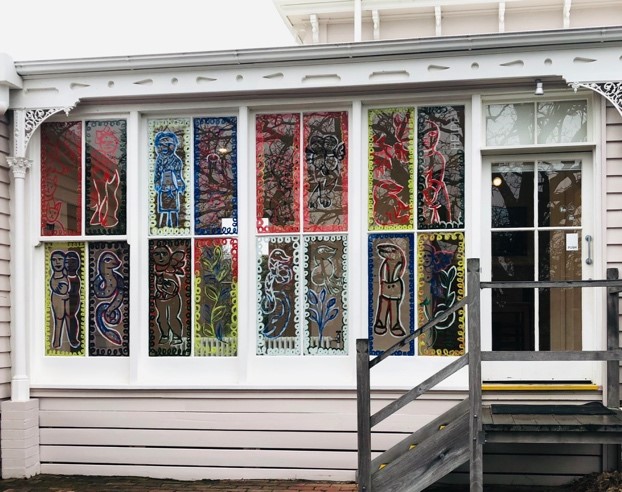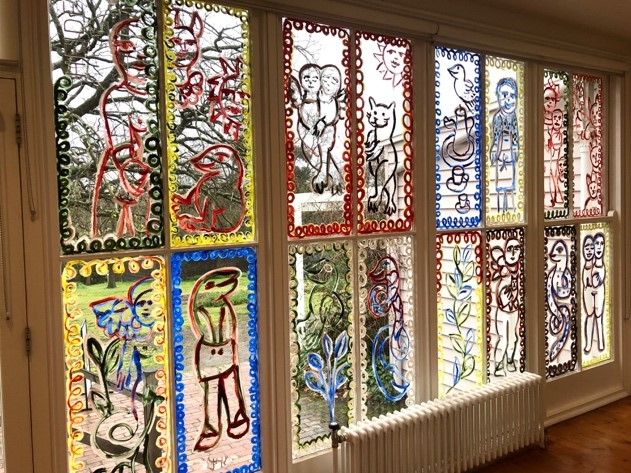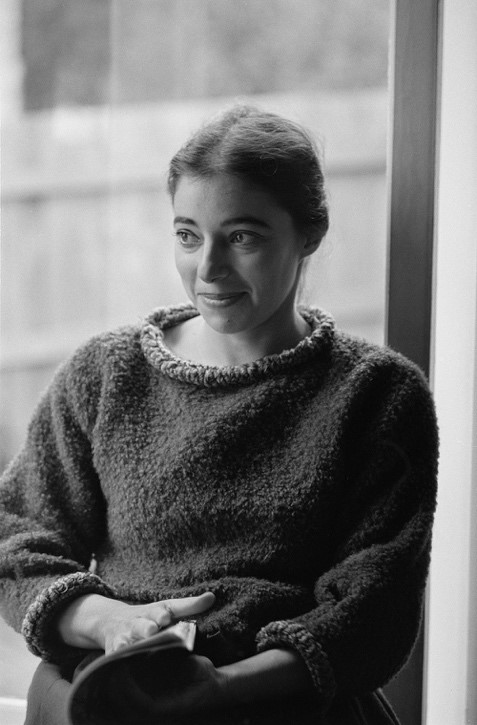A short story by Victoria Souliman (University of New England, Australia)
It was a rainy afternoon in Bulleen, an outer Melbourne suburb. We had decided to visit the famous home of John and Sunday Reed, influential art patrons throughout the 1930s, 40s and 50s, which is now known as the Heide Museum of Modern Art. As we rushed to the entrance of the house and out from the rain, a series of colourful drawings painted directly on the front sunroom windows caught my eye. It was a series of fantastical creatures, angels, cats, birds, and snakes featured in bold yellow, red, white, and blue lines – a style immediately recognisable. These had been drawn by the hand of Mirka Mora.


Mirka Mora’s mural on the sunroom windows at the Heide Museum of Modern Art
Through the colourful and playful style of her art, Mirka conveys her story: one of survival and migration. She was born in Paris, to a Lithuanian Jewish father and a Romanian Jewish mother and when aged 14, was arrested in 1942 during the Vel’ d’Hiv Roundup. However, she and her family managed to escape the concentration camp at Pithiviers in Loiret (France) and the inevitable deportation to Auschwitz. Having survived the Holocaust, they spent the remainder of the war hiding in the French countryside. In 1951, fearing the prospects of a nuclear war, Mirka with her husband and son migrated to Melbourne, Australia.
Why Australia? In her autobiography Wicked but Virtuous (2000), Mirka explains that she chose the destination country of her family based on Henri’s Murger’s Scènes de la Vie de Bohème, in which one of the characters travels to Melbourne to make his fortune. A few months after arriving, Mirka told her husband ‘Look I have to have a studio. I have to paint, I can’t stay here.’1 For Mirka, art was a means to explore her subconscious and engage with her experience during the Holocaust, her trauma, where she came from, and her own self as a migrant. She worked across many different media such as painting, sculpture, mosaic, and embroidery – as a glimpse at the Heide Museum’s collection reveals. The unique iconography used in her work, for instance, draws from the Romanian folklore, and at times it is reminiscent of motifs used in Marc Chagall’s work. Other sources of her imagery also include classical mythology and events in her own life. Artmaking enabled Mirka to channel her emotions and find resilience in her experience of migration, which was undoubtedly an act of self-preservation and re-invention.
In my research I have been looking at creative Australian women travelling to England and France, but the COST Action Women on the Move has inspired me to investigate the mobility of women originating from Europe. I have developed more curiosity for the stories of French-born women who migrated to the Antipodes, explored their various experiences of migration through their art and who had an impact on the artistic and cultural scenes there.

Mirka Mora in 1961
Soon, Mirka connected with other migrants, artists, and art patrons in Melbourne, including John and Sunday Reed. In fact, Mirka painted the mural on the sunroom windows of the Reeds’ house in 2010 to pay homage to their friendship. She was welcomed by the Melbourne’s artistic community and she occupied a central place in its bohemian circles: during the 1950s and 60s, the Moras opened several cafés where painters, poets, musicians, philosophers, journalists, and politicians came.2
Mirka was 90 years old when she passed in 2018. Although she is little known in France, she is today one of Melbourne’s most beloved cultural figures. This year, to celebrate the 70th anniversary of her arrival in Australia, a number of museums are holding dedicated exhibitions of her artworks as well as displaying artefacts retracing her story from a post-World War II migrant to a prolific artist. Such celebrations help to reveal the significant impact of women’s migration on Australian artistic and contemporary culture.
1. Mirka Mora interviewed by Sheridan Palmer in the Australian art from 1950 to the present oral history project. 8 February 2012. https://nla.gov.au/nla.obj-219070902/listen/0-469~0-494
2. Mirka Mora interviewed by Sheridan Palmer in the Australian art from 1950 to the present oral history project. 8 February 2012. https://nla.gov.au/nla.obj-219070902/listen/0-816~0-833
References:
- Mora, Mirka (2000) Wicked but Virtuous: My Life (Penguin: Ringwood, Victoria)
- Palmer, Sheridan (2012) Australian Art from 1950 to the Present, Oral History Project. https://nla.gov.au/nla.obj-219070902/listen/0-469~0-494 and https://nla.gov.au/nla.obj-219070902/listen/0-816~0-833 [last accessed 6/01/2023]
- Heide Museum. https://collection.heide.com.au/explore [last accessed 6/01/2023]